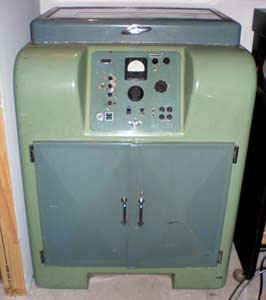
In the early 1950s I was working in local government and any form of sound recording seemed for me far out of reach. A Ferrograph, or even home-built machines based on the Brenell or Collaro decks were too expensive to contemplate. The electronics also was a bit beyond me.
Then in April '54 I became a trainee technical author at EMI and there, parked in the middle of the Writer's Room, was a BTR/2.
I quickly found out this was a Rolls Royce of recorders. A Fred Bennett was the Senior Writer engaged in the preparation of the Service Manual and I elected to assist with this job whenever I could. A sight to see at the 'Dawley Works' - part of the EMI complex - was serried ranks of these machines in the various stages of manufacture.
I became quite friendly with Fred Bennett. He was a quiet, introverted sort of fellow: a bachelor, living with his father. Fred and I lunched together at the various eating houses in Hayes. He was musical and we attended a number of concerts, notably a great rarity: one of the two Promenade Concerts ever conducted by Sir Thomas Beecham.
We also witnessed in the Festival Hall, a demonstration organised by Gilbert Briggs of Wharfedale Loudspeakers fame. He was joined by Peter Walker of the Acousical Manufacturing Co. - Quad. The platform was an interesting sight. On either side were Quad Electrostatic speakers, arranged in 'stacks'. The big Wharfedale corner loudspeakers were there also and the combination of the two types gave a very satisfactory sound in that auditorium. Centre stage was seating for four musicians, a C12 microphone on a stand - and a BTR/2.
The proceedings were compered by Gilbert with typical urbane Yorkshire wit. Most items were from records, played with great assurance by Peter Walker from an elaborate and very substantial (concrete plinths etc.) set-up in the Royal Box. (It was intriguing to see the co-operation between the MDs of competitors Wharfedale and Quad.)
Incidentally, Gilbert demonstrated that not all recordings were suitable for reproduction by this means. Shortcomings in the hall reverberation response were highlighted. A good venue in this respect was the Concertgebouw in Amsterdam.
The BTR/2 had a part to play in the finale of the evening. Members of a string quartet filed on to the platform, sat down and played a short piece. This was recorded - with the 'clunk' of those solenoids sounding well in that Hall! Operation was with great aplomb by Ken Brazier, a colleague from EMI Publicity. Then the musicians rested their bows and we listened to the result via the array of loudspeakers.
Fred and I agreed the realism was excellent. Great care had obviously gone into the microphone placement and, perhaps more important, the volume level setting of the repro system.
For the last few months of my time at EMI I was actually promoted to Technical Author with responsibility for the 'odds and sods' - amongst others the Emidicta Office Dictation Machine and a new high quality gramophone pick-up known as the EPU100.
In the latter part of '55 I received an offer from the Sperry Gyroscope Co. which I thought I should not refuse, and became an author there. It was interesting stuff, aircraft flight instruments and I progressed to being an instructor in the Aero School.
But I hankered after the BBC and began applying for various posts. In June '58, after three attempts, I finally succeeded and became a Probationary Technical Operator in the Television Service.
To my surprise tape was not as yet used in television studios. Any sound recording was done 'down the line' to a disc channel at BH and the 'acetates' brought to us by special courier.
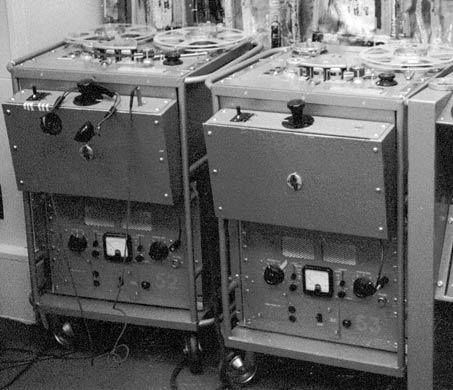
I was to use the TR/90 for several years, being now a 'Tape and Grams Operator' - at Grade C - no less!
Quite a lot of my work was on the 'Wednesday Play' series. These were lavish affairs with music often specially composed. I was able to attend many of the recording sessions, usually in a sound radio music studio - Aeolian Hall, Maida Vale 3 and the like.

An interesting sideline to working in sound radio music studios was that for each session, the microphones would be set out and cabled by the studio attendants. I would turn up all ready to rig and find the job done. It was a privilege they specially guarded. It lead to some strange mic types and positioning being used - such as an AXBT, carefully angled, on a Celesta. Sounded just right when you faded it up though.
Then to Sound Supervisor in '65 and in '73 a move from London TV Centre to Birmingham Pebble Mill.
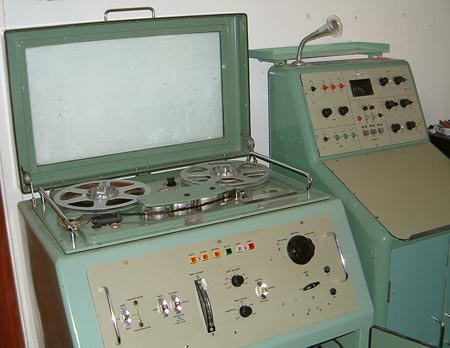
It seems that the Beeb in the late forties bought very many of the original BTR/2s - I heard the figure of 750 mentioned. These were now long in the tooth: mono and with relatively unstable valve operation. But, being akin to the Rolls Royce, the mechanical units were still sound, in fact many hardly showed signs of wear.
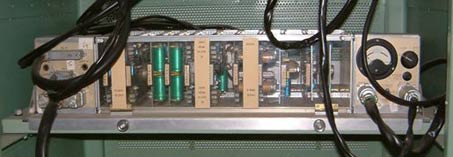
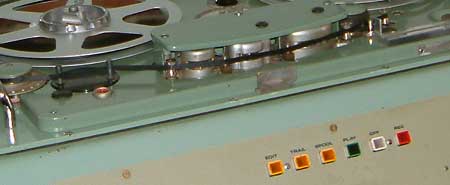
The RD4/4 was meant to bridge the gap between the start of stereo broadcasting and the advent of good quality commercial machines, such as the Studer B62.
It soon became apparent that there were two serious snags to the RD4. Its long-term speed stability was poor and the azimuth setting of the heads rather wayward. The first fault was a great embarrassment in a broadcasting organisation where material had to be timed to the second and repeatable throughout the corporation. An attempt to cure this was the provision - at some great expense I imagine - of crystal controlled precision power supplies. The second shortcoming could be minimised by skilled adjustment and great care with the fixing of the head block cover.
Not all studios were stereo capable when I arrived in '73. Just two music and the radio drama studios. The installation was typical of BBC practice at the time. A large and well appointed control room (known in radio parlance as 'the Cubicle') and a separate recording room ('the channel'). The idea was that the Studio Manager balancing the programme would not be disturbed by the workaday noises of the recording machines and operators.
This state of luxury didn't last. The Studer machines were smaller and quieter. Programmes became more complex compilations rather than the old-fashioned broadcast of a performance.
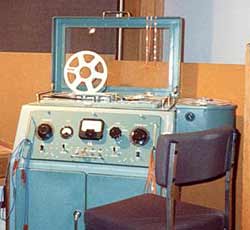
The combination of a console recorder and two 'ears', one either side, provided a very powerful editing tool. 'A' and 'B' reels would be loaded on the two left-hand platforms; reels for the 'Compilation' and 'Out-takes' on the right and a programme assembled very quickly with minimum changing of reels (always time consuming and prone to material mix-ups).
Early on in my new life at Pebble Mill I saw advertised in the BBC Staff Magazine 'Ariel', a BTR/2 with a London phone number. The owner turned out to be a Kingswood Warren development engineer who was to be posted to the World Service relay station at Singapore. The machine had been acquired more for sentimental reasons than as a workhouse or museum piece I think. The fellow had met his wife when they both worked at Bush House: he an engineer, she a studio manager. They courted whilst she 'slaved over a hot BTR/2'!
The machine he told me, was a complete commercial version, and had originated from the Diplomatic Wireless Service where it had been used to record facsimile radio pictures. He asked £100, I offered £80 which was accepted. I don't think he had any other replies to his advert.
So, off from Upton Snodsbury in Worcestershire to Tunbridge Wells. Luckily we had a reasonably commodious five door saloon at the time. Even so some ingenuity was needed to pack it all in. Back home to a bemused family and a programme of overhaul.
All in all the green monster was not in too bad a condition, considering it had lodged in a Kentish garage for some years. The Front Panel had a nasty scar where a fine speed control had been rather crudely installed (for picture synchronising purposes I assume).
When the Replay Amplifier was switched on a terrible noise ensued. This was traced to a faulty wire-wound resistor in the anode circuit of the first stage. Easily cured; as was a rather pronounced hiss (this by carefully selecting the EF37A for minimum reverse grid - or 'gas' - current).
Because of the almost video recording previous use, the Monitor Amplifier had a modified circuit to provide a DC-restored output. This took quite a lot of work to return it to proper function.
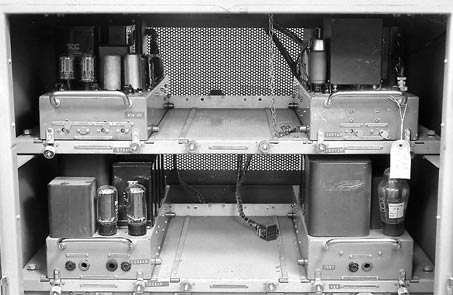
The performance of my machine as a whole was disappointing because of worn tape heads and pronounced speed variation - 'flutter'. The first was to be put right when other machines came into my possession. Flutter needed a bit more thought. The trouble seemed to be a flexible coupling in the capstan drive. The rubber had obviously hardened with age and heat. I devised a home-made replacement - cobbled out of an inner tube I think.
My BTR/2, quite apart from being a hobby of restoration, also became a most useful tool for work. I would record the first day's rehearsal, say of 'Songs of Praise', bring home a couple of 15ips reels and listen to my efforts in a domestic setting, away from the hustle and bustle of the venue - and mark my script with improvements to be achieved.
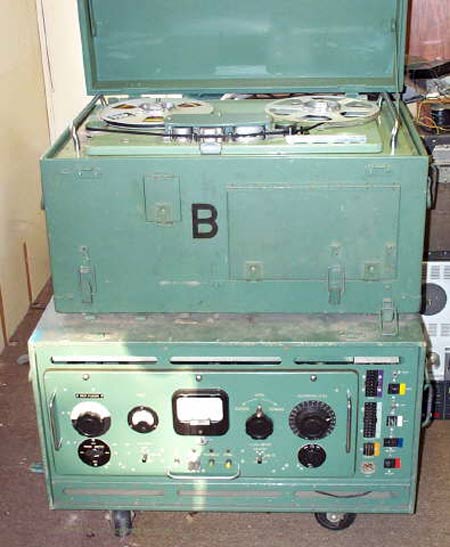
The two machines (A and B boxes only) were almost brand new. So I was able to solve my head-block problem straight away.
I soon found that a BBC BTR differed from the commercial version in a number of ways, mainly to do with the Control Panel Line Out arrangements and monitor circuits. After a bit of thought I decided to modify all units I had to make everything work with everything else.
I now felt, as an owner of two working machines, I could find out if there were other enthusiasts using these venerable monsters. Classified adverts in 'Studio Sound' and other trade magazines brought in a number of replies, eventually about twelve in all.
Hospital Radio seemed to be a favourite resting place. Alistair Biggar ran such an outfit in Glasgow. His machine was used by the Station for tape editing; the other volunteers not wanting to be involved in the quite tricky maintenance needed. Alistair's 'day job' was as an engineer in Scottish Television Control Room.
Rex Baldock wrote to say he too had tried to start an 'owners club' some years previously. He had four BTR/2s and a BTR/3 in his front room! His was a sizeable house and he a bachelor; needless to say.
The BTR/3 looked on the exterior very much like its senior. Inside was neat shelf of plug-in miniature valve units instead of the octal 'blockbusters'.
A David Hurlock contacted me and explained he was able to buy BBC redundant plant, also for hospital radio use. With some friends, this had become a sizeable operation (registered as NAHBO - National Hospital Broadcasting Organisation) supplying equipment and programme material to stations. His day job was telephone engineer. An invitation to Midhurst, West Sussex ensued and a free box of BTR/2 spares promised. His house was another mine of treasures.
Related page
I found many useful things in the gift box. New head blocks in original wooden cases; another with stereo heads fitted.
My next project was obviously stereo repro. I had plenty of material in the form of scrapped light music tapes (recorded in Studio 2, Pebble Mill on RD4/4s). The stereo head block was installed in my original console and a transportable case B parked alongside to provide a second replay chain. It was a bit of a lash-up but the results were very pleasing.
I eventually persuaded Dave Hurlock to sell me one of his RD4/4s and a Linking Console DK1/5: £25 and £60 respectively. The latter had a broken PPM; after a while DH supplied a (much more up-to-date) replacement. Installing this gave me the opportunity to provide a 'slugging' function; so useful for adjusting head azimuths.
A combination of the RD4 and DK1/5 I found disappointing from the point of view of background noise and hum. A better bet would have been a DK1/4, an altogether superior job with rotary stud faders. I did find one, but it was rotting in Dave Hurlock's garden!
Terry Warneford got in touch. He lived at Malvern in a large Victorian house with two ladies who I believe were sisters. In the commodious cellar he kept a collection of old broadcast gear. There was a TR/52 I remember (the semi-professional EMI of circa 1960). Also a rather run-down BTR/2.
We corresponded, mainly about Terry's ambition to record, on a rather ancient reel to reel Shibaden video recorder, the final few minutes of 405-line transmission from Sutton Coldfield. I was able to assist him in this by persuading the EiC at Sutton to guarantee a full rated output on the day. Terry sent me some off-screen photos of the final Weather Forecast. Then we lost touch.
Some while later I received a letter from one of the ladies at the house, a Miss Brown: 'Mr Warneford had left and removed his collection from the basement - all but a large and very heavy green thing. Could I oblige by removing it please?' I found that David Hurlock was interested, so yet another console came to Harran for onward transmission!
Two of the other contacts made via by BTR/2 adverts were: Deryck Jones (in charge of the Electronics Lab at the Natural History Museum and a keen hospital radio volunteer) - we exchanged a new head block for a PPM Amplifier; and Peter Appleby (lighting engineer for Anglia Television) who had a complete commercial transportable version, but set some pretty impossible exchange demands for it.
Next, Alan Mercer gave me his BBC Transportable - his wife having refused to house it any more.
A strange event was a 'phone call offering me two BTR/3s for £200. Although this price was more than I was prepared to spend on this hobby, I agreed to meet the chap at Junction 4 on the M40. Just before the due date and time he rang me to say his house had burnt down and the two machines lost!
A more successful transaction, eventually, was with Peter Appleby. He was finally persuaded to part with his transportable. The quid pro quo? The copying of his treasured 30ips jazz master tapes on to modern tape at 15ips. This, with some crafty arranging - including an all night session in the Dubbing Theatre at PM - I was able to accomplish. An inveigled 'Down Your Way' OB arranged at Norwich allowed me to complete the exchange.
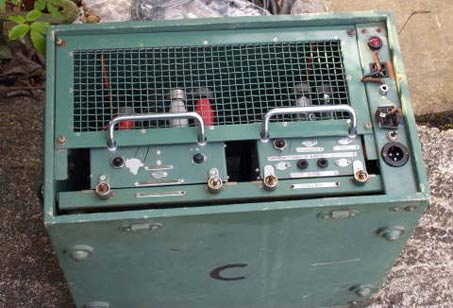
Eventually I gave the threesome to Bob Marriot.
A number of people at Pebble Mill gave me advice and help over the years. John Cheshire, who ran the mechanical side of Engineering Services, was a mine of information and gave me a few tit-bits, including a set of extension leads for bench testing individual units; very useful.
Radio Engineering Services were run by John Noble. He gave me much - amused - encouragement and even arranged for the crane used (and by now discarded) to hoist mechanical units from console cabinets to be delivered to my home 'on long term loan'. A sturdy piece of apparatus, rather like a car-engine hoist. Although I have lifted these 64kg 'built like battleships' units using a series of boxes and chairs (a risky business) the crane made light work of it.
Eventually, space at home became a premium, so I decided to find a home for my original console, all my ¼inch tape activities now being serviced by a Nagra 3 (from Dave Hurlock) a stereo Teac (redundant from Pershore Talking Newspaper) and the RD4/4. Some years back, whilst on a holiday exploring the archaeological remnants of the Forth/Clyde canal, I had stumbled on the Museum of Communications in a tiny quayside house at Bo'Ness. Run on a shoestring, nevertheless it had the support of an enthusiastic band of volunteers and of Scottish BT, who had mounted a most impressive exhibition of the museum's artefacts in their Edinburgh headquarters building.
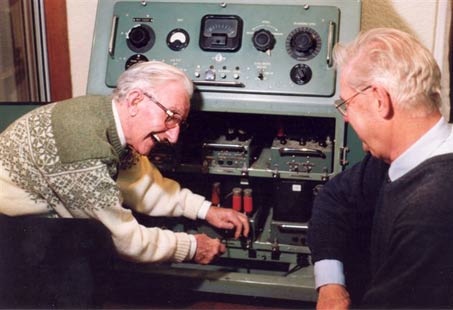
Then came Minidisc and I finally transferred my allegiance from ¼inch tape. The new system, although considerably data compressed, satisfied my ears - very low background noise. Editing, although 'destructive' is nearly as good as with a razor-blade - but not quite!
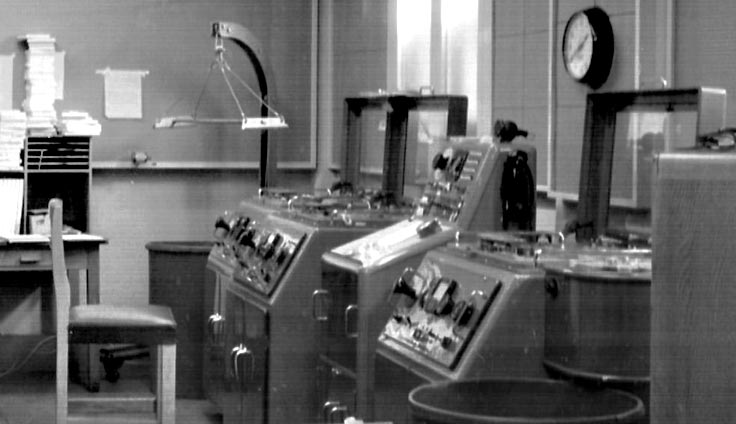
Another Cardiff recording channel, this time W7 in the old BH in Park Place. The machine nearest the camera has the third spool attachment mentioned above. In the far corner is a crane which enabled the heavy deck to be changed by a single engineer or accessed for mechanical repair. After disconnecting the deck from the amps which were contained in the cabinet below, the deck was winched up and wheeled clear on the crane. The sloping panel hinged forward for accessing deck connections prior to removal. The J section extrusions hooked under the deck handles. Two engineers could remove the deck but it was awkward. In London a trolley was used to transport the decks between the Transit Room where maintenance spares were held and the recording channel and to transport the faulty deck to the workshop for attention.
The photo was sent by Jim Bartlett who adds a couple of memories:
Part of the operator's line-up procedure every morning was to measure the noise, 7½ ips and 15 ips, rec and rep. If a machine was out of tolerance, worse than -60dBs, the first step, before writing an EFR (Engineering Fault Report) and phoning maintenance, was to de-mag the heads. This was done with something the size and shape of a green mallet, which was mains powered. It was a good idea to remove your wristwatch before plugging it in! As you slowly approached the headblock with it, all the bits of loose metal around the deck would start to vibrate. You would take it right up to the rep head, then back away and go in again on the other two heads in turn. After turning the de-magger off, you'd measure the noise again, and hope that you hadn't actually made things worse!
The BTR2, like the other studio machines in Cardiff, the TR90 and the Philips, was full-track mono. However reporters went out with half-track mono Uhers. This was OK, until they came back with material on both tracks, having either turned the tape over, or re-used old tape. Tapes like that had to be copied and for this job the BTR2 headblock had to be changed to a block with a half-track repro head. The wooden box this came in also contained a spanner for the job.
A photo of a channel in Pebble Mill, Birmingham shows that editing on BTR2s could sometimes be an uncomfortable process!
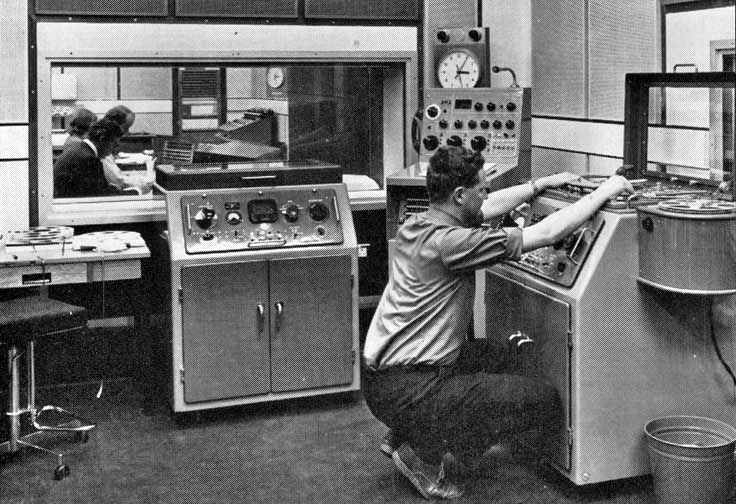
The BTR/2 at Alexandra Palace
Ken Banwell recalls that at Alexandra Palace in the early 1960s, BBC News had a pair of BTR/2s along with a disk recording machine in SRU (Sound Recording Unit).
They were used to record incoming dispatches from around the world on tape. After editing the tapes, two copies were made to 78rpm disk for TX.
One of the BTR/2's capstan motor could be run from a audio power amp with a variable frequency output of about 40 to 60 Hz. This was used if we had film shot at 24 frames per second with a separate audio tape. As we played film at 25 fps we needed to speed up the audio. The capstan connection was though the audio jack field normalled for mains lock and over patched for amplier drive! It was labelled in RED. Health and Safety would have had a field day.
A colleague of mine was at Abbey Road in the late 1950s and was instrumental in using tape echo with a BTR/2 running at variable speed, one of Cliff Richard's records was the first use it.
Footnote - The BTR/1
